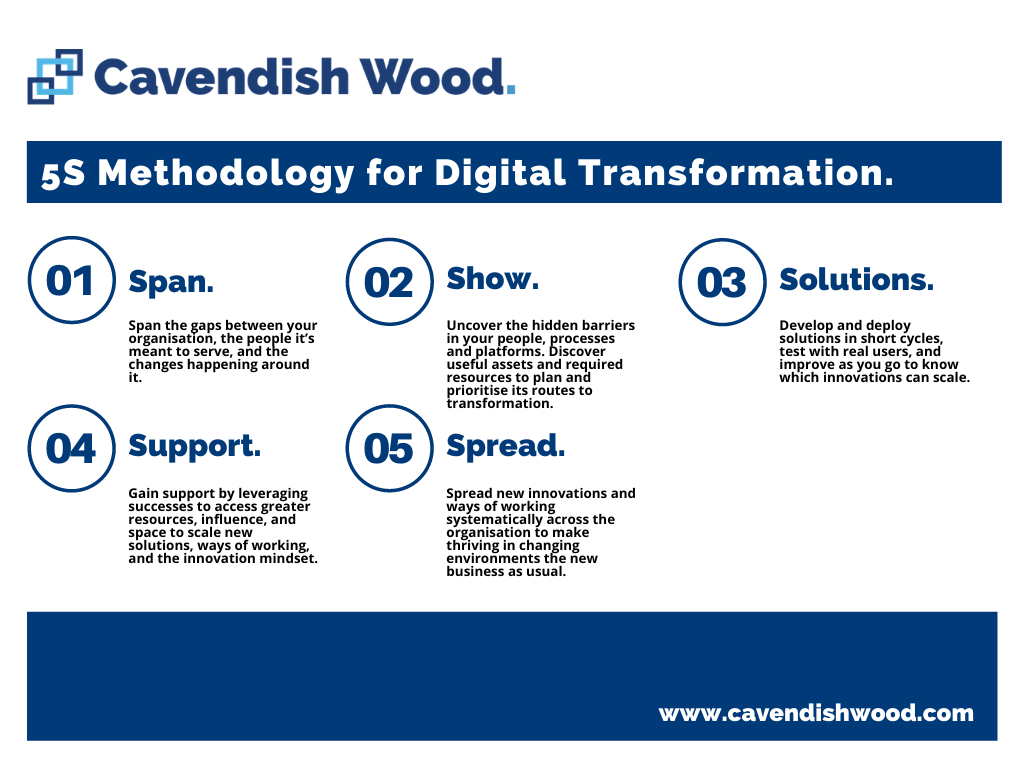
In my previous blog post, I delved into the foundational steps for digital transformation in the private sector, focusing on the unique challenges and opportunities that CEOs, Senior Business Leaders, CIOs and CTOs face. We explored the "Span" phase of our 5S Methodology for Digital Transformation, a framework honed through years of collaboration with both public and private sector organisations.
Cavendish Wood's 5S Methodology for Digital Transformation.
Today, we're moving on to the second phase of this methodology: "Show". In the "Span" phase, you established vital connections and dialogues with stakeholders, both internal and external. You used this valuable data to define a "Shared Vision for Transformation", setting the stage for your organisation's digital journey. You also put together a leadership team to steer this transformation, ensuring resources and budgets are allocated effectively.

Show.
In the "Show" phase, your focus will be on identifying and eliminating the barriers that could derail your transformation efforts. You'll also locate essential assets and resources, and begin planning and prioritising the initial projects that align with your digital vision.
Key objectives of "Show":
- Identify the hidden barriers in your people, platforms, and processes that could jeopardise the transformation.
- Uncover assets that can accelerate the transformation process.
- Determine the business outcomes that digital projects will deliver to help the organisation achieve its vision.
- Identify and start filling any skill and resource gaps.
- Establish a benefits management capability to track the service, financial, and efficiency gains from the transformation.
- Deploy the first cross-functional teams to begin delivering solutions.
How to "Show"
The primary goal of this phase is to reveal existing barriers within your organisation that could impede transformation. These barriers could be anything from outdated technology to a resistant company culture, and they need to be addressed to avoid wasting time, money, and effort.
The good news is that there's a structured approach to identifying these barriers, applicable across sectors. By following the steps outlined here, you'll be able to:
- Identify the barriers within your organisation.
- Combine them with the gaps discovered during the "Span" phase.
- Formulate the initial projects that should be tackled by the cross-functional teams you'll deploy at the end of this phase. These projects, known as "Pathways to Transformation", are crucial for your organisation's digital success.
By diligently following the "Show" phase of the 5S Methodology, you set the stage for a successful, sustainable digital transformation, ensuring that your organisation is well-equipped to navigate the complexities of today's digital landscape.

What are the barriers to transformation in the private sector?
It's crucial to understand that barriers to digital transformation are not the same as typical business challenges like market growth, product adoption, or profitability. These barriers are unique impediments that can halt an organisation's ability to adapt to rapid technological changes and evolving customer expectations.
Digital transformation is not merely about adopting new technologies; it's about a holistic transformation of your organisation. The first step in this transformative journey is identifying the barriers that could potentially stop you in your tracks. While this may seem like a daunting task, the good news is that there's a universal commonality in these barriers, making them easier to identify and address.
For a structured approach to this phase, it's beneficial to categorise your organisation into three distinct areas where most barriers to transformation are likely to be found:
People.
This category encompasses everything related to your staff, from roles and responsibilities to organisational culture and management styles. Whether it's resistance to change or a lack of digital skills, people can often be the most significant barrier to transformation.
Processes.
This involves every operational aspect of your organisation, including both internal and external transactions, rules, workflows, and ways of working. Outdated or inefficient processes can seriously hamper your transformation efforts.
Platforms.
This refers to all things related to IT and technology within your organisation. While technology is an enabler of digital transformation, outdated or incompatible platforms can be a significant barrier.
By breaking down your organisation into these three areas, you significantly increase your chances of successfully identifying and mitigating the barriers that could derail your digital transformation. This structured approach ensures that you leave no stone unturned in your quest for a successful, sustainable transformation.
People barriers in the private sector.
Let's be clear: your people can be the most significant barrier to successful digital transformation. Regardless of how talented or open to change they seem, they pose a risk that must be acknowledged and managed. This is a hard truth, but it's essential for the success of your transformation journey.
Three common people barriers in digital transformation.
#1 False logic.
One of the most prevalent ways people become barriers is through false logic, often encapsulated in the phrase, "This is how we've always done it, so it must be right." Overcoming this barrier is usually straightforward: identify the source of the flawed logic and demonstrate why it's incorrect. Once people see that their way of thinking is inefficient, they are generally willing to change.
#2 Poor Accountability.
Another way people can hinder transformation is through a lack of accountability, particularly concerning their contribution to the company's core objectives. In a digitally mature organisation, every action should be measured against its contribution to the company's goals. Without this level of accountability, employees will continue with business as usual, making any investment in new technology essentially pointless.
This lack of accountability is often exacerbated by inward-focused management that doesn't align performance metrics with the company's core objectives. Functions like IT and HR must also be accountable for the productivity they enable. Key Performance Indicators (KPIs) should not just be about 'keeping the lights on'; they should incentivise innovation and better organisational performance.
Accountability should be directly linked to the transformation vision set in the first phase, "Span," which we'll discuss in more detail later.
#3 The absence of an innovation mindset.
The most frequent stumbling block in digital transformation is the lack of an innovation mindset. This is not just about being open to new ideas; it's about fostering a culture that actively encourages change, rewards innovation, takes calculated risks, and learns quickly from both successes and failures. Such a mindset is inherently collaborative and builds consensus, propelling your digital transformation forward with a unified purpose.
The corporate culture reality check.
Contrast this with the prevailing mindset in many private sector businesses, particularly among the C-suite. You'll often find a culture steeped in hierarchy, where caution is rewarded and risk-taking is discouraged. This risk-averse attitude is almost embedded in the organisation's DNA, leading to missed opportunities for innovation and learning.

The technology trap.
Even with the most advanced technology solutions at your disposal, a stagnant mindset will render them ineffective. For instance, many companies have invested heavily in platforms like Microsoft 365, SharePoint, and MS Teams. Despite the significant financial outlay, the impact is often minimal if the organisational culture doesn't change.
In such scenarios, SharePoint becomes nothing more than a cloud-based file storage system, Teams is relegated to conference calls, and the only real change is that Outlook can now be accessed from home. No one is leveraging SharePoint's workflow capabilities or experimenting with Power Platform to automate manual processes. In essence, the technology becomes an expensive tool that fails to bring about any meaningful transformation.
The cost of inaction.
To put it bluntly, the absence of an innovation mindset can be costly. I've seen organisations where the digital transformation budget has run into millions, with little to no change to show for it. This is not just a waste of resources; it's a missed opportunity to evolve and stay competitive.
In summary, the right mindset is crucial. Without it, even the most advanced technology stack and a limitless budget won't bring about the digital transformation your organisation needs to stay ahead in today's fast-paced business environment.
Cultivating a culture of innovation and digital accountability.
Creating a culture that embraces digital transformation is about more than just implementing new technologies; it's about changing mindsets. This involves demonstrating the tangible benefits of digital initiatives and encouraging your teams to take calculated risks. As you move into the next phase of the 5S methodology, "Solutions," it's crucial to adopt an iterative approach, empowering cross-functional teams to tackle business challenges creatively.
The power of visible benefits.
When employees can see the positive impact of digital initiatives, they're more likely to buy into the transformation process. Accepting mistakes as valuable learning opportunities is a cornerstone of a digital culture. This shift in perspective encourages teams to embrace a more agile, innovative way of thinking and acting.
Digital KPIs: The new metrics for success.
To further incentivise this cultural shift, consider incorporating digital-focused Key Performance Indicators (KPIs) into individual development plans. Changing the metrics by which success is measured is essential for fostering an innovative mindset. Otherwise, digital projects risk becoming sidelined or treated as optional tasks.
Here are three categories of digital KPIs to consider:
#1: Input KPIs.
These KPIs aim to keep innovation at the forefront of daily operations. They measure the activities that contribute to a culture of innovation:
- Generating new ideas
- Participation in sprints or hackathons
- Contributions to the development of innovation programmes
- Attendance at industry conferences or meet-ups
- Participation in customer research or innovation surveys
- Engaging in training sessions or workshops
#2: Output KPIs.
These KPIs measure the tangible outcomes of innovative work, reinforcing the idea that everyone has a role to play in digital initiatives:
- Building prototypes
- Running experiments
- Data collection
- Customer engagement in digital initiatives
- Results from training sessions or workshops
#3: Hard KPIs.
These are the most critical KPIs, as they measure the actual business outcomes achieved through innovative efforts:
- Products developed and deployed
- New customer acquisition
- Revenue generation
- User sign-ups
- Cost savings
- Time savings
By adopting these KPIs, you're not just encouraging a culture of innovation; you're making it a measurable, accountable part of your organisation's DNA. This approach is essential for any private sector business aiming to successfully navigate the complexities of digital transformation.

Identifying people barriers: A scoring mechanism.
The most effective way to pinpoint barriers related to your team members is through a scoring system. While it's not necessary to evaluate each individual, it's crucial to assess teams and key roles at all levels. Use the following criteria to score each team or role:
Openness: How receptive are your team members to change?
Adaptability: How well do they adapt when changes are implemented?
Accountability: To what extent are they accountable for the organisation's overall success?
By scoring these elements, you can identify where additional support and resources are needed to facilitate a smoother transformation journey.
Uncovering process barriers.
The next step is to identify barriers within your organisation's processes. These can generally be categorised into three types:
- Operational Processes: These are the processes that facilitate both internal and external operations.
- Working Practices: These refer to the methodologies your organisation employs to deliver business outcomes.
- Decision Flows: These are the mechanisms through which your organisation makes decisions.
#1: Over-reliance on manual inputs.
If your processes are heavily dependent on manual inputs and lack automation, they will inevitably slow down your organisation. This is particularly problematic in sectors that have not yet fully embraced digital transformation. For instance, processes that involve multiple manual steps—like printing, re-keying, scanning, and uploading documents for review—are not just time-consuming but also energy-draining and detrimental to customer experience. Given the availability of automation tools, such as Microsoft 365, there's no reason for these manual processes to persist.
#2: Excessive decision points.
Processes that require multiple decision points at every stage can severely hamper progress. This issue is prevalent across all types of processes and is usually easy to identify. Signs include multiple layers of reviews, sign-offs, "Go/No-Go" meetings, and checkpoints.
By addressing these barriers, you're setting the stage for a more streamlined and effective digital transformation. This is particularly crucial for CEOs, Senior Business Leaders, CIOs and CTOs in the UK's private sector, where agility and efficiency are key competitive advantages.
Assessing and prioritising process barriers.
Just like with people barriers, it's crucial to evaluate and rank the process barriers within your organisation. This can be a complex task, given that processes often overlap or are interconnected. Focus first on the processes that have the most significant impact on customer experience, as these are vital to your digital transformation. Then, turn your attention to processes that consume the most time, energy, and budget.
To effectively assess each process, score them based on the following criteria:
Value: Does the process add value in a way that directly aligns with the organisation's core objectives? Does it enhance the user or customer experience?
Measurability: Are all inputs and outputs of the process quantifiable? Can they be tracked to evaluate the process's overall performance?
Current Best Practice: Is the process in line with industry best practices, or can it be verified as such by an external expert?
By scoring your processes against these criteria, you'll be better positioned to identify which ones need immediate attention and optimisation. This is especially relevant for the UK's private sector, where operational efficiency can be a significant differentiator.

Identifying platform barriers.
The last frontier for uncovering barriers to digital transformation lies in your IT platforms. These platforms should be enhancing your organisation's efficiency, elevating customer experience, facilitating effective collaboration, and aiding in data analysis and decision-making.
Understanding the strengths and weaknesses of your IT platforms is crucial for focusing your efforts effectively. While there won't be any quick fixes, recognising these barriers will allow you to proactively plan and navigate around them.
Your IT infrastructure serves as the bedrock of your digital transformation journey. To keep pace with external digital changes, your systems should exhibit specific characteristics. The main types of barriers you'll likely encounter in your platforms can be categorised into four areas:
Incompatibility with systems or users.
Platforms that are not compatible or easily integrated with other systems can significantly hinder digital transformation. This also extends to user compatibility. If a system is cumbersome or requires specialised training for basic tasks, it's a clear barrier to progress.
Sluggish performance.
A slow platform not only frustrates customers but also hampers internal operations. In today's digital age, there's no room for sluggish platforms that undermine agility and performance.
Lack of scalability.
Your IT platforms should be capable of handling increased demands in capacity. If they can't adapt to rapid changes or scale to meet new functionalities, you're facing a scalability barrier.
Complexity and underperformance.
These barriers often arise when a platform is either misconfigured or too cumbersome for the tasks it's supposed to perform. If your system has been manipulated to perform functions it wasn't designed for, or if it required multiple configuration changes to fit your operational needs, untangling it for future scalability will be a challenge.
For CEOs, Senior Business Leaders, CIOs and CTOs in the UK's private sector, understanding these platform barriers is essential. It allows you to make informed decisions, ensuring that your digital transformation strategy is not only robust but also agile.
Assessing platform barriers.
Just like with people and process barriers, it's essential to evaluate your platforms to identify priority areas. To achieve this, utilise the FACE value framework:
F – Fast
Does the platform operate swiftly, and can your team easily modify, upgrade, or customise it? If you need external experts for minor changes, that's a red flag.
A – Accessible
Is the platform user-friendly and accessible from various locations? Does it require specialised training for basic operations?
C – Clever
Can the platform collect and analyse data to provide actionable and consistent insights?
E – Extendable
Is the platform capable of integrating with other systems, devices, or networks, with the flexibility to add more as needed?
Mapping the Paths to Transformation.
Now that you've identified and scored your key barriers using the 5S methodology, what's the next step? You'll need to outline the initial projects that your cross-functional teams will tackle to start realising your digital transformation vision.
"Paths to Transformation" refers to the essential business outcomes that individual projects must deliver to achieve the overarching vision.
Unlike traditional project delivery methods, these paths don't dictate the sequence of projects or their execution methods. This flexibility is crucial, given the numerous unknown variables and multiple ways to achieve the desired outcomes at this stage.
To identify these paths, combine the shared vision with the known barriers. For instance, let's revisit a statement from the first phase, "Span":
"Customer data should be collected and stored once at first contact only and be available to any department across the organisation that requires it, to create a more positive customer experience and save time and costs."
What barriers have you identified in your people, platforms, or processes that could prevent you from realising this part of the vision? These barriers become your paths to transformation. Prioritise them and don't overlook any, especially those related to people. This may result in various individual projects, each requiring empowered, cross-functional teams to deliver iteratively using Agile methodologies.
In the next article, we'll delve into how to execute these paths as we explore phase three of the 5S methodology, "Solutions."

Benefits management: The unsung hero of digital transformation.
One of the most commonly overlooked yet crucial elements of digital transformation is benefits management. For any transformation initiative to be deemed successful, it's vital to measure the success of each individual project within your paths to transformation.
Essentially, the goal is to quantify the benefits of the work in relation to its cost. To do this effectively, break down each project into three types of benefits:
Financial benefit.
What is the projected financial gain from achieving the project's objectives over the next year and the subsequent three to five years?
Efficiency benefit.
How many person-hours will the project save over the next year and the next three to five years? This should be quantified in monthly hours.
Service benefit.
What improvements in service or customer experience can be expected? Although challenging to measure, this is crucial. Does the project reduce the number of touchpoints a customer has to go through? Will it speed up order delivery?
It's essential that these forecasts come from the people who are directly involved in delivering the service, rather than speculative estimates from the IT department. The programme team should then validate these forecasts and provide detailed cost estimates for the proposed solutions.
Once you have this mechanism in place, prioritising projects becomes a much more straightforward task. This data also equips executives with the insights needed to allocate more resources, budget, and scope to your digital transformation programme.
In a future article, I'll delve deeper into this topic as we explore phase four of the 5S methodology, "Support." This phase is all about securing essential senior-level backing to accelerate your transformation efforts.
At this juncture, you're well-equipped to kickstart the initial projects on your digital journey. It's imperative that these projects employ an iterative development approach, are business-led, and continuously guided by real-world user feedback. Stay tuned for the next article, where we'll discuss how to execute this in the subsequent phase of transformation, "Solutions."
For CEOs, Senior Business Leaders, CIOs and CTOs in the UK's private sector, understanding and implementing benefits management is not just a nice-to-have but a must-have. It provides the metrics that justify digital transformation, ensuring that your initiatives are not just technologically sound but also business-savvy. Click here to read "Solutions" now.

